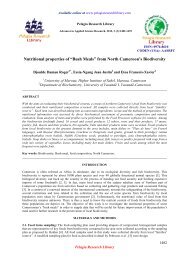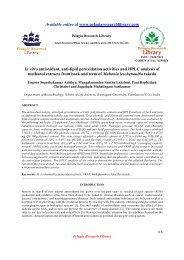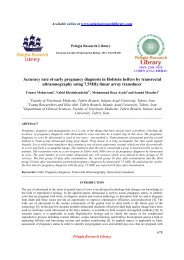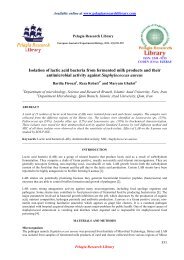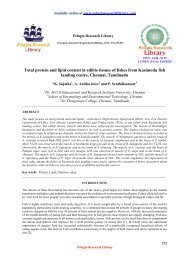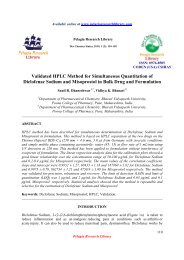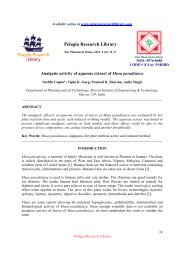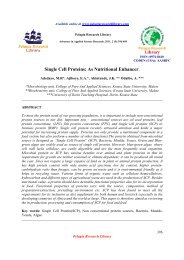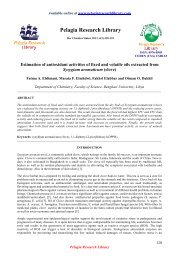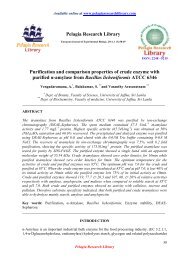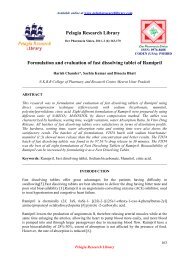Chemical characteristics of low-fat wheyless cream cheese ...
Chemical characteristics of low-fat wheyless cream cheese ...
Chemical characteristics of low-fat wheyless cream cheese ...
You also want an ePaper? Increase the reach of your titles
YUMPU automatically turns print PDFs into web optimized ePapers that Google loves.
Khadijeh Poursharif et al Euro. J. Exp. Bio., 2012, 2 (3):690-694<br />
______________________________________________________________________________<br />
The terms and definitions used to describe <strong>fat</strong> replacers vary among authors and are <strong>of</strong>ten confusing and<br />
misunderstood. Fat replacers chemically resemble to <strong>fat</strong>s, proteins, or carbohydrates and are generally categorized<br />
into two groups: <strong>fat</strong> substitutes and <strong>fat</strong> mimetics. Fat substitutes are macromolecules that physically and chemically<br />
resemble to triglycerides(conventional <strong>fat</strong>s and oils) and ,<strong>of</strong>ten, referred to as lipid- or <strong>fat</strong>-based <strong>fat</strong> replacers. Fat<br />
substitutes are either chemically synthesized or derived from conventional <strong>fat</strong>s and oils by enzymatic modification.<br />
Fat mimetics are substances that imitate organoleptic or physical properties <strong>of</strong> triglycerides. Fat mimetics, <strong>of</strong>ten<br />
called protein- or carbohydrate- based <strong>fat</strong> replacers, are common food constituents, e.g., starch and cellulose, but<br />
may be chemically or physically modified to mimic the function <strong>of</strong> <strong>fat</strong>. Fat mimetics generally adsorb a substantial<br />
amount <strong>of</strong> water [3].<br />
In recent years, many studies related to <strong>low</strong> <strong>fat</strong> Mozzarella or Cheddar <strong>cheese</strong>s have been published [4-8]. However,<br />
other <strong>cheese</strong>s with higher levels <strong>of</strong> consumption, such as <strong>low</strong> <strong>fat</strong> s<strong>of</strong>t <strong>cheese</strong>s, have received much less attention.<br />
Whey produced from <strong>cheese</strong> making (including <strong>cream</strong> <strong>cheese</strong>), as a by- product, limits productivity. Whey has few<br />
uses and results in the loss <strong>of</strong> valuable proteins for the <strong>cheese</strong> product. The production <strong>of</strong> whey can also create<br />
additional costs for waste treatment, even though whey contains food grade ingredients which have been separated<br />
from milk. The inability <strong>of</strong> whey proteins to be retained in <strong>cheese</strong> is an important factor contributing to a lake <strong>of</strong><br />
efficiency in the production <strong>of</strong> <strong>cheese</strong>, including reduction in overall yield and increased costs [9].Although whey<br />
has sometimes been further processed to obtain food ingredients, the acid whey generated <strong>cream</strong> <strong>cheese</strong> product<br />
cannot normally be utilized in this manner. It would be desirable, therefore, to provide a process for making <strong>cream</strong><br />
<strong>cheese</strong> in which whey is retained in the final product [10].<br />
Wheyless <strong>cream</strong> <strong>cheese</strong> is a s<strong>of</strong>t <strong>cheese</strong> containing more than about 65 percent moisture with a high whey<br />
protein/casein ratio (e.g., about 60/40 or higher) and with desirable firmness which does not involve whey separation<br />
[10].<br />
The most recent definition says that probiotics are live microorganisms administered in amounts that positively<br />
affect the health <strong>of</strong> the host [11, 12].In addition to the probiotic approach <strong>of</strong> directly introducing live bacteria to the<br />
colon through dietary supplementation, another approach to increase the number <strong>of</strong> beneficial bacteria, such as<br />
bifidobacteria, in the intestinal microbiota is through the use <strong>of</strong> prebiotics. Prebiotics are non-digestible dietary<br />
components that pass through to the colon and selectively stimulate the proliferation and/ or activity <strong>of</strong> populations<br />
<strong>of</strong> desirable bacteria in situ [13]. Inulin is a linear β (2 1)-linked fructose polymer that occurs in garlic, asparagus<br />
root, Jerusalem artichoke, dahlia tubers or chicory root [14]. It is a carbohydrate- based <strong>fat</strong> replacer.<br />
Fresh <strong>cream</strong> <strong>cheese</strong> is a <strong>cheese</strong> obtained from the homogenization <strong>of</strong> a fresh <strong>cheese</strong> base with further ingredients,<br />
including gums and hydrocolloids, salt and other spices. This <strong>cheese</strong> is a versatile food that permits addition <strong>of</strong> other<br />
ingredients, including fibres like inulin. It has a spreadable structure, and is used as a spread on bread, in sandwiches<br />
and as a salad dressing. It is an unripened <strong>cheese</strong>, stored at refrigeration temperatures, and the shelf life is rather<br />
limited [15].<br />
The incorporation <strong>of</strong> inulin, as a partial <strong>fat</strong> replacer, specifically in <strong>wheyless</strong> <strong>cream</strong> <strong>cheese</strong>, has not been previously<br />
reported. Therefore, the objective <strong>of</strong> this study was to examine the effect <strong>of</strong> level <strong>of</strong> inulin incorporation on the<br />
chemical properties (pH, <strong>fat</strong>, dry matter, moisture and salt) <strong>of</strong> <strong>wheyless</strong> <strong>cream</strong> <strong>cheese</strong>. For this purpose, the <strong>wheyless</strong><br />
<strong>cream</strong> <strong>cheese</strong> with different contents <strong>of</strong> inulin was produced and investigated.<br />
MATERIALS AND METHODS<br />
2.1 Additives<br />
The fol<strong>low</strong>ing additives are involved in the production <strong>of</strong> <strong>wheyless</strong> <strong>cream</strong> <strong>cheese</strong>:<br />
• Two stabilizers: locust been gum (LBG, Robertet, The Netherlands) and carrageenan (CL220, Danisco,<br />
Denmark).<br />
• Dairy proteins consisted <strong>of</strong> skim milk powder (SMP, Iran), whey protein concentrate (WPC, Progel, Netherlands)<br />
and sodium caseinate (EM7, Netherlands), to provide an aqueous dairy protein blend.<br />
• Inulin (Frutafit TEX, SENSUS, Netherlands) .<br />
• Coagulant (Standard rennet, Chy-Max, Chr, Hansen Inc., Denmark: 183 International MilkClotting Units<br />
(IMCU)/mL (International Dairy Federation, 1997)) .<br />
Pelagia Research Library<br />
691




